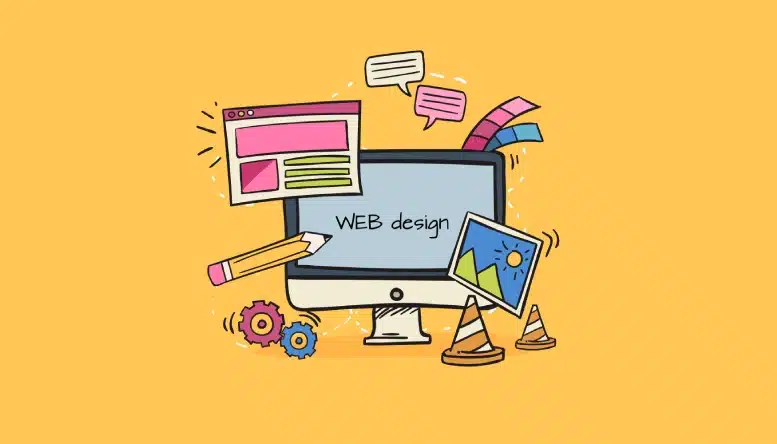The importance of responsive layouts explained by a top web design company
Wiki Article
The Significance of User Experience in Efficient Web Design Techniques
User experience (UX) functions as a foundation in reliable web design strategies. It forms just how customers engage with a site, affecting their complete satisfaction and probability of returning. A properly designed UX can enhance interaction with instinctive navigation and responsive formats. Nonetheless, forgeting these elements may lead to frustration and increased bounce prices. Recognizing the intricacies of UX is necessary for developers intending to develop engaging digital experiences that resonate with diverse audiences. What variables truly drive successful user engagement?Understanding User Experience and Its Effect on Layout
User experience (UX) is typically perceived as a simple aspect of internet design, it essentially shapes how users engage with an internet site. UX incorporates all aspects of the user's interaction, including usability, ease of access, and general complete satisfaction. A favorable UX cultivates engagement, encouraging individuals to explore the site and return in the future. On the other hand, an unfavorable experience can cause stress, causing high bounce rates and shed possibilities for conversion.Design aspects like navigating, content, and format company play important functions in shaping this experience. Reliable UX design prepares for user demands and preferences, guaranteeing that details is aesthetically attractive and conveniently accessible. Furthermore, comprehending user habits via analytics can offer valuable insights, notifying style decisions that enhance use. Ultimately, a complete understanding of UX enables designers to produce sites that not only attract customers however also advertise significant interactions that line up with service goals and user assumptions.
Trick Principles of Effective User Experience
Effective user experience pivots on a number of essential concepts that enhance internet site capability and interaction. Intuitive navigating layout, receptive layout basics, and the relevance of visual power structure are important components that add to a smooth communication in between individuals and web material. Recognizing these principles enables developers to create more easy to use and obtainable digital atmospheres.User-friendly Navigation Style
When individuals encounter a website, user-friendly navigating layout serves as a crucial entrance to their general experience. Efficient navigating permits users to effortlessly locate the info they seek, boosting their interaction with the site. Trick concepts include clear labeling, sensible organization, and constant positioning of navigating elements. Tags need to be simple, permitting customers to predict the web content they will locate. A well-structured pecking order assists customers comprehend the connection between different areas, directing them with the website seamlessly. Additionally, responsive food selections and easily available web links contribute to a fluid experience across gadgets. By prioritizing intuitive navigating, developers can greatly decrease user irritation and boost involvement, eventually fostering a favorable understanding of the site and its web content.Receptive Format Fundamentals
A well-structured navigating system naturally results in the demand for a responsive format, which is crucial in today's varied electronic landscape. A receptive layout warranties that websites feature effortlessly throughout numerous tools, including desktops, tablets, and smartphones. This flexibility boosts user experience by enabling content to be conveniently available and visually meaningful, despite display size. Secret concepts of responsive layout consist of fluid grids, flexible photos, and media inquiries, which facilitate optimal watching. Furthermore, prioritizing touch-friendly elements boosts interaction on mobile phones. By carrying out a responsive design, developers can fit individuals' needs, lessen bounce prices, and rise engagement. Inevitably, a well-executed responsive style cultivates a positive user experience, encouraging site visitors to explore the website better.Aesthetic Pecking Order Relevance
Aesthetic hierarchy plays a necessary duty in guiding users with an internet site, ensuring that important info records their focus. By tactically making use of dimension, contrast, color, and spacing, designers can create a clear path for customers to comply with. Larger aspects typically attract the eye, indicating their importance, while contrasting shades can highlight phone call to activity. In addition, constant alignment and grouping of related content improve comprehension, making navigating user-friendly. Reliable use of aesthetic power structure not only boosts use yet additionally sustains the general aesthetic of the site, promoting a favorable user experience. When individuals can quickly identify the most crucial information, they are more probable to involve with the material, resulting in enhanced complete satisfaction and interaction with the internet site.The Duty of Functionality in Web Design
Functionality plays a crucial role in web design, particularly through navigation simpleness and adherence to ease of access criteria. Effective navigating boosts user fulfillment by allowing visitors to locate information rapidly and with ease. On the other hand, conference ease of access criteria guarantees that all individuals, no matter their capacities, can effectively engage with the website.Navigation Simpleness
Simplicity in navigation stands as a keystone of efficient web design, greatly affecting user experience. A structured navigating system enables individuals to find info promptly and intuitively, decreasing irritation and enhancing complete satisfaction. Clear labeling and sensible structure are necessary elements, leading users effortlessly via the website. Redundant links or overly complex menus can confuse customers, bring about raised bounce prices. Furthermore, mobile responsiveness should be thought about, making sure navigation remains straightforward throughout devices. Decreasing and focusing on vital web pages clutter even more supports user interaction. Efficient navigation not just cultivates a favorable experience but also encourages users to explore the site much more extensively, ultimately leading to higher conversion prices. In this respect, navigation simpleness acts as a crucial factor in the overall effectiveness of web design approaches.Accessibility Requirements
User interaction is greatly boosted when web sites adhere to access requirements, ensuring that all individuals, no matter their capabilities, can navigate and connect efficiently. Conformity with these requirements not only widens the target market however likewise improves total user contentment. Easily accessible style includes attributes such as message alternatives for photos, keyboard navigating, and adequate color comparison, which help with usage by people with impairments. On top of that, carrying out these standards can favorably influence search engine optimization (SEO) by boosting website framework and clearness. As web design evolves, focusing on accessibility becomes necessary in fostering a comprehensive digital environment. read By embracing these standards, designers add to an extra fair internet, eventually driving user commitment and involvement.Importance of Responsive Design for User Engagement
As customers significantly access sites through a variety of devices, the importance of receptive layout becomes paramount for engaging users effectively. Receptive style guarantees that an internet site adjusts seamlessly to different screen dimensions, supplying a suitable viewing experience despite the gadget used. This flexibility enhances user interaction by helping with less complicated navigating and communication with content.When customers experience a web site that is responsive, they are more most likely to remain longer, check out additionally, and return in the future. A properly designed responsive design reduces the stress often connected with scrolling and zooming on smaller sized screens, consequently lowering bounce prices. In addition, receptive style can positively affect internet search engine rankings, as internet search engine prioritize mobile-friendly websites. In today's digital landscape, where mobile use continues to rise, executing receptive design is not simply useful, however essential for keeping user interaction and assuring a favorable experience across all devices.
Enhancing Load Times for Better User Satisfaction

To enhance load times, web developers must focus on optimizing photos, leveraging web browser caching, and minimizing HTTP demands. Furthermore, using Web content Shipment Networks (CDNs) can accelerate content delivery by dispersing it throughout various geographic places. Streamlining code, such as pressing CSS and JavaScript documents, even more adds to faster loading rates.
Inevitably, a commitment to enhancing tons times not just improves user satisfaction but also enhances brand loyalty and enhances the possibility of repeat brows through. A swift, smooth experience is essential for retaining customers and fostering positive interactions.
The Influence of Visual Pecking Order on User Communication
Aesthetic pecking order serves as a crucial aspect in directing user communication on a website. By organizing material in such a way that prioritizes info visually, developers can affect how customers involve and navigate with a site. This hierarchy is established through numerous layout methods, including size, shade, comparison, and spacing. For example, bigger fonts or bold shades attract focus to critical components, such as contact us to action or headlines, while restrained colors and smaller sized font styles can indicate subservient details.Reliable aesthetic pecking order helps customers swiftly identify what is crucial, minimizing cognitive load and improving usability. It enables user-friendly navigating, making it easier for individuals to discover what they require without frustration. As individuals interact with a website, a well-structured visual power structure promotes a much more gratifying experience, ultimately bring about greater interaction and conversion rates. Developers should prioritize these concepts to produce an user-centered and efficient web setting.
Measuring User Experience: Techniques and tools

Often Asked Concerns
Just How Can I Enhance My Internet site's User Experience on a Spending plan?
To boost a web site's user experience on a spending plan, one can enhance web page lots speed, streamline navigating, execute responsive style, enhance content quality, and collect user comments for constant improvements, making certain a gratifying visitor experience.What Prevail User Experience Errors to Stay Clear Of in Web Design?
Typical user experience mistakes in web design consist of chaotic designs, inadequate navigation, sluggish packing times, absence of mobile responsiveness, neglecting access, irregular branding, and stopping working to prioritize user feedback - agency for web design. Each can considerably Continue hinder total site efficiency
How Commonly Should I Update My Internet Site for Better User Experience?
Internet sites need to be upgraded on a regular basis, ideally every few months, to keep perfect user experience. Constant updates help address usability issues, rejuvenate web content, and adapt to changing user needs, ensuring the website stays appealing and relevant.
Can User Experience Influence SEO Rankings on My Site?
User experience can greatly influence SEO rankings, as online search engine prioritize internet sites that use seamless navigation, fast loading times, and engaging content. A favorable user experience can result in reduced bounce prices and higher search exposure.What Duty Does Ease Of Access Play in User Experience Style?
Accessibility plays an important function in user experience layout by ensuring that all individuals, no matter capacities, can navigate and engage with a web site properly. This inclusivity enhances overall fulfillment and involvement amongst diverse customers.User experience (UX) is frequently perceived as a simple aspect of web layout, it basically shapes exactly how customers interact with a website. User involvement is substantially improved when sites adhere to access requirements, making sure that all users, no matter of their abilities, can browse and engage properly. Measuring user experience (UX) is essential for recognizing just how properly an internet site fulfills the demands of its customers. In addition, usability testing, where actual customers navigate the website while observers note difficulties, provides straight responses on user experience. Typical user experience errors in internet design consist of messy layouts, inadequate navigation, slow-moving filling times, lack of mobile responsiveness, disregarding availability, inconsistent branding, and stopping working to prioritize user responses.
Report this wiki page